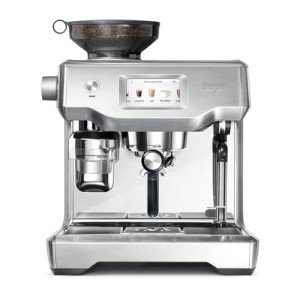10 Quick Tips On Italian Espresso Machines

Heat Exchange Espresso Machines: A Comprehensive Guide
Espresso machines have actually evolved substantially for many years, dealing with the requirements of home baristas and coffee specialists alike. Amongst these machines, heat exchange espresso machines have gotten popularity due to their ability to provide consistent efficiency and extraordinary brew quality. In this post, we will check out the operations, benefits, and important features of heat exchange espresso machines, offering a detailed understanding for both possible buyers and coffee enthusiasts.
Comprehending Heat Exchange Technology
Heat exchange espresso machines operate on an unique principle that allows synchronised water heating for developing and steaming. click over here are equipped with a single boiler that uses a heat exchanger system. This feature is significant as it makes it possible for users to brew espresso while steaming milk simultaneously, promoting effectiveness in the coffee-making process.
How Does a Heat Exchange Espresso Machine Work?
The process begins with the machine's water inlet filling the boiler. As the water heats up, it turns to steam. The innovative heat exchanger uses hot steam to heat additional water in a separate passage designed specifically for the brew group. This implies that water can reach the ideal developing temperature level without waiting on the boiler to change. The crucial steps consist of:
- Water Fill: Water is drawn into the boiler.
- Heating Process: The boiler warms up as water is converted into steam.
- Heat Exchange: Steam warms water in the heat exchanger tube.
- Developing: Water from the heat exchanger is pushed through coffee grounds, extracting the tastes required for an abundant espresso.
This process enables quick temperature changes and improved coffee extraction.
Benefits of Heat Exchange Espresso Machines
Heat exchange espresso machines use several advantages, especially for those wanting to maximize their coffee experience. Here are some crucial advantages:
- Simultaneous Brewing and Steaming: Users can brew espresso while steaming milk, making it perfect for hectic coffee shops and home baristas who value efficiency.
- Temperature level Stability: The boiler's steam pressure helps keep a stable temperature level, which is crucial for constant espresso extraction.
- Versatility: The style allows for fast changing between brewing and steaming, making it much easier to produce various coffee beverages, from lattes to cappuccinos.
- Easy to use: Models frequently feature available controls, making it practical for both newbies and knowledgeable baristas to produce quality drinks.
- Professional Quality: Heat exchange machines are frequently utilized in commercial settings, providing users with high-quality brewing efficiency in the house.
Key Features to Look for in Heat Exchange Espresso Machines
When thinking about the purchase of a heat exchange espresso machine, there are a number of functions that one must take into consideration:
- Build Quality: Look for machines made of durable materials, such as stainless-steel or brass, ensuring longevity.
- Boiler Size: A bigger boiler will hold more water and sustain greater output in time.
- PID Temperature Control: This function assists preserve consistent brew temperatures, which can boost the coffee-making process.
- Group Head Design: Machines with a saturated or semi-saturated group head supply better temperature level stability.
- Reduce of Use: User-friendly user interfaces and user-friendly controls improve the general experience for baristas at all ability levels.
- Steam Wand Quality: A good steam wand with correct insulation and versatility enables better texturing of milk.
- Water Reservoir Size: Depending on your needs, consider how frequently you want to fill up the water tank.
Comparison of Popular Heat Exchange Espresso Machines
To better comprehend the options offered in the market, listed below is a contrast table of some popular heat exchange espresso machines:
| Machine Model | Boiler Size | PID Control | Rate Range | User Ratings |
|---|---|---|---|---|
| Profitec Pro 700 | 2.0 L | Yes | ₤ 2,000-₤ 2,500 | 9.5/ 10 |
| Rocket Espresso R58 | 1.8 L | Yes | ₤ 2,400-₤ 2,800 | 9.4/ 10 |
| Elekta Bianca | 1.8 L | Yes | ₤ 2,500-₤ 3,000 | 9.6/ 10 |
| La Spaziale S1 Vivaldi II | 1.5 L | Yes | ₤ 1,800-₤ 2,200 | 9.2/ 10 |
| Bezzera Magica | 1.2 L | No | ₤ 1,600-₤ 1,800 | 9.0/ 10 |
Frequently Asked Questions About Heat Exchange Espresso Machines
What is the primary difference between a heat exchange and a dual boiler espresso machine?
While both types can brew espresso and steam milk at the exact same time, dual boiler machines have separate boilers for brewing and steaming. In contrast, heat exchange machines use a single boiler and a heat exchanger to accomplish the same function.
Are heat exchange machines suitable for newbies?
Yes! Lots of heat exchange machines are created with easy to use functions, making them accessible for novices. With appropriate guidance and practice, users can quickly produce quality espresso.
What kind of maintenance do heat exchange espresso machines require?
Regular upkeep includes descaling, cleaning up the boiler, inspecting seals and gaskets, and keeping the group head tidy. Routine upkeep ensures durability and constant efficiency.
Can I use a heat exchange machine for various types of coffee beverages?
Absolutely! Heat exchange machines permit users to develop a variety of coffee beverages, including espresso, lattes, cappuccinos, and more.
Heat exchange espresso machines represent a mix of development and custom, providing coffee enthusiasts with the tools needed for crafting the best cup. Their capability to all at once brew and steam, integrated with precise temperature level control, makes them an engaging choice for both home baristas and professionals. With the ideal understanding on functions and upkeep, users can open a world of elegant coffee experiences, ensuring that each sip is as delightful as the last.

